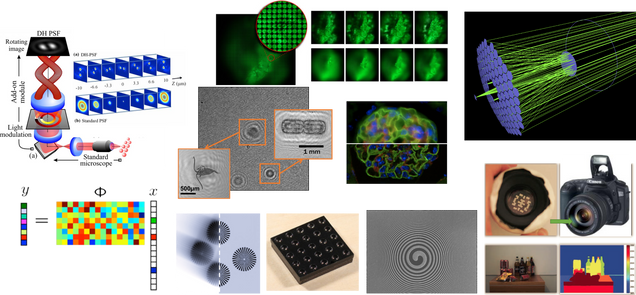Teaching
My teaching schedule for academic year 2021-2022:
- 2022 Spring: ENG EC 522 Computational Optical Imaging

Recent years have seen the growth of computational optical imaging – optical imaging system that tightly integrates optical hardware and computational algorithms. The result is imaging systems with capabilities that are well beyond with traditional methods. Computational optical imaging systems have a wide range of applications in consumer photography, scientific and biomedical imaging, microscopy, defense, security and remote sensing. This course looks at this new design approach as it is applied to modern optical imaging, with the focus on the tools and techniques at the convergence of physical optics, and signal processing.
The course is heavily evaluated by class project, which includes 1) literature review and 2) computational implementation of a chosen technique. Class projects in Spring 2022 are:
- Lensless imaging: Boominathan, Vivek, et al. “Phlatcam: Designed phase-mask based thin lensless camera.” IEEE transactions on pattern analysis and machine intelligence 42.7 (2020): 1618-1629.
- Lightfield imaging: Feng, Xiaohua, and Liang Gao. “Ultrafast light field tomography for snapshot transient and non-line-of-sight imaging.” Nature communications 12.1 (2021): 1-9.
- 3D LSV imaging: Yanny, Kyrollos, et al. “Miniscope3D: optimized single-shot miniature 3D fluorescence microscopy.” Light: Science & Applications 9.1 (2020): 1-13.
- Computational photography: Antipa, Nick, et al. “Video from stills: Lensless imaging with rolling shutter.” 2019 IEEE International Conference on Computational Photography (ICCP). IEEE, 2019.
- Computational coherent imaging: Lindell, David B., Gordon Wetzstein, and Matthew O’Toole. “Wave-based non-line-of-sight imaging using fast fk migration.” ACM Transactions on Graphics (TOG) 38.4 (2019): 1-13.
- Computational fluorescence microscopy: Xuanwen Hua, Wenhao Liu, and Shu Jia, “High-resolution Fourier light-field microscopy for volumetric multi-color live-cell imaging,” Optica 8, 614-620 (2021).
- Computational diffuse optical imaging: Liu, Chao, et al. “High resolution diffuse optical tomography using short range indirect subsurface imaging.” 2020 IEEE International Conference on Computational Photography (ICCP). IEEE, 2020.
Prerequisites:
linear algebra, e.g. EK102 or MA142
linear systems, e.g. EC401
Fourier analysis, e.g. EC401
Multivariate Calculus, e.g., MA225
MATLAB / Python Programming skills, e.g. EK127
Readings:
There is no single textbook that sufficiently covers all the materials in this course. Below is a list of books that can prove useful for various parts of this course. You are also expected to rely on lecture notes and supplementary material that will be uploaded regularly to the course website, such as journal papers.
Main Text for the math in the course:
M. Bertero, P. Boccacci, Introduction to Inverse Problems in Imaging, (Taylor), ISBN 9780750304351
Additional (optional) references:
(For more in-depth reading on optics)
D. Brady, Optical Imaging and Spectroscopy, (Wiley), ISBN 9780470048238
J. Goodman, Introduction to Fourier Optics, 4th Edition. ISBN: 978-1-319-11916-4
- 2021 Fall: ENG EC 401 Signals and Systems
Continuous-time and discrete-time signals and systems. Convolution sum, convolution integral. Linearity, time-invariance, causality, and stability of systems. Frequency domain analysis of signals and systems. Filtering, sampling, and modulation. Laplace transform, z-transform, pole-zero plots. Linear feedback systems. Includes lab. 4 cr.